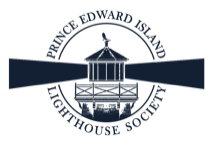Victoria Seaport Lighthouse
Victoria Harbour features six range lights used to direct marine traffic into the once busy seaport, including Leard’s Front and Back range lights, Palmer’s Front and Back range light, and Wright’s Front and Back range lights. In addition to numerous fishing fleets in the region, Victoria provided a vital link with the mainland, and ships like the SS Harland regularly traveled between Victoria and Pictou, Nova Scotia.
The Leard’s Front and Palmer’s Back range lights are unique on the Island as they are each located in the same building. The two lights are distinguished by colour – green for Leard’s Front and red for Palmer’s Back – and by the differently shaped and coloured day marks on the side of the tower.
The Leard’s Front and Palmer’s Back range light tower houses the Victoria Seaport Museum, which features exhibits on the history of Victoria, the range lights, and lightkeepers.
Victoria Seaport History
Victoria was once one of Prince Edward Island’s busiest seaports. The story of the harbour, the range lights, their keepers and the community are presented in the Victoria Seaport Museum, which opened in 1990. It is operated by a non-profit group. In addition to the fishing and farming industries in the region, Victoria provided a link to the mainland. Ships like the S.S. Harland carried passengers on the three hour trip to and from Pictou, Nova Scotia.
The museum is housed in the small square tower that is unique on PEI as being the only light structure with two different range lights. The Leard’s Front Range Light is located directly above the long dark red striped day mark that extends from the lantern deck to the top of the window. The Palmer’s Back Range Light is directly above the triangular light red day mark that is attached to the metal railing of the lantern deck.
There are six range lights to direct marine traffic into the harbour. As mentioned, Leard’s Front Range and Palmer’s Back Range are in one building located at the West end of the causeway near the Visitor Information Centre and the wharf. The Palmer’s Front Range is simply a red light on top of a triangular day mark on a platform in the water between the wharf and the Visitor Centre.
The Leard’s Back Range Light is located inland in a private area with Coast Guard access. It was built in 1878. The tower was moved in 1901. It was originally an open frame tower that was enclosed after 1913. It is 13.7 m (45 feet) high. There are no floors to divide the different levels in the tower – only small platforms where the keeper could pause as he carried the oil up the steep and narrow stairs to the top. Before the construction of Leard’s Back (or inner) Range Light in 1879 a light was placed in the gable window of Solomon Leard’s house, hence the name Beacon House.
The Wright's Front and Back Ranges are further west from the inner harbour. The Front Range is at the end of a farm field at the edge of a cliff called Paul’s Bluff. It is the first range light mariners see as they approach the harbour. It was built in 1903 to replace an earlier structure that was essentially a 2 m (6 foot) tall shed with a beacon attached to a short mast. Wright’s Front Range is unlike most Island range lights in that it has no lantern room. Instead, the light shines from a window on the top floor. It has a red day mark on the seaward wall and is 3.7 m (12 feet) high. It is a purely utilitarian light devoid of any ornamentation. It was automated in November, 1959.
Wright’s Back Range is very similar to Leard’s Front Range. It was built in 1896. The white shingled tower is 9.7 m (32.6 feet) high. It is located on a private lawn at the end of the Beach Light Road. The range lights were named for long-time keepers Charles L. Wright, who kept the range lights from 1894-1935, and his son Charles Evan Wright, who kept the lights from 1936-1959.
The Victoria Seaport Museum is small but has a great deal of information, including photographs and interpretive panels on Victoria and its history, lighthouse technology, and lightkeepers. A number of artefacts and historic documents are also on display, including a 1904 Rules and Instructions for Lightkeepers for the Dominion of Canada.
There is a steep set of stairs leading to the second floor. A hatch in the ceiling of the second floor provides access to the third floor. On the third floor is a storage bench and shelf unit where the keeper kept supplies and reports. The narrow windows look out over the village and harbour. The interior walls are clad with white-painted boards arranged diagonally. A second set of steep, narrow stairs leads to the tiny lantern room which is large enough for only one person. The space is taken up by two Wallace and Tiernan lights that guide boats into the picturesque harbour. From the lantern room one has an excellent view of the village with its numerous historic homes and other attractions.
